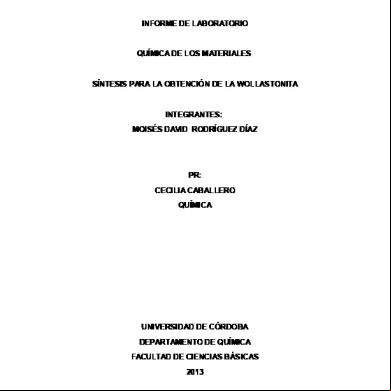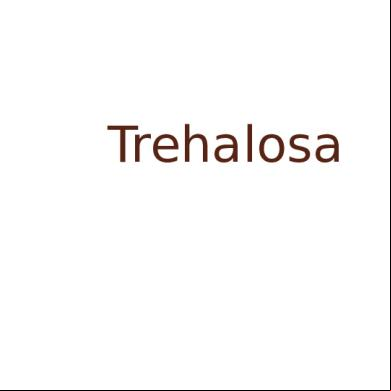Chemistry Project On Qualitative Analysis Of Various Soft Drinks 16f1
This document was ed by and they confirmed that they have the permission to share it. If you are author or own the copyright of this book, please report to us by using this report form. Report l4457
Overview 6h3y3j
& View Chemistry Project On Qualitative Analysis Of Various Soft Drinks as PDF for free.
More details h6z72
- Words: 1,231
- Pages: 19
This project placed here, is a result of the kind guidance, careful supervision and timely assistance rendered
to
me
by
our
honorable
chemistry
teacher “Mr. A.K.Sinha”. This
project
would
not
have
been
completed
without the timely suggestion provided by our honorable
teacher
who carefully groomed and
nurtured me throughout the academic year. Special thanks go to my parents and family
for
their
constant
and
a
conductive congenial atmosphere for learning at home. I am grateful to my principal who has encouraged me constantly. All has provided me with all the facilities.
This is to certify that MILIND RAJ DIXIT of class XIIth MATHS “A”, Roll No. for the session of 2015-2016 has effortlessly, successfully completed this project in chemistry on “QUALITATIVE ANALYSIS OF VARIOUS SOFT DRINKS” in the partial fulfillment of the practical examination in the CHEMISTRY-AISSCE under my guidance and the supervision. It is recommended that it may be accepted for the purpose of examination. Head of Department
CHEMISTRY
About The Project Aim Of The Project Materials Required Test Performed On Various Soft Drinks Graph Charring Test Soft Drinks And Health Conclusion Bibliography
ABOUT THE PROJECT
My
friends
and
I
have
found
that
the”
Qualitative Analysis of various soft drinks” the most interesting and informative amount the list of projects in curriculum. Several tests were done on various soft drinks brought in the school laboratory under the instructive guidance of our chemistry teacher ‘Mr. A.k.Sinha”. We did the test for the presence of glucose, sucrose & ethyl alcohol. Charring tests were done to find time, amount of sugar content in the brands. The pH values of the drinks were found using pH scale provided. Thus, we were able to compare the various brands of soft drinks and thereby make graph to show accurate comparisons.
AIM OF THE PROJECT
The “Qualitative analysis of Various Brands Of Soft Drinks” aims at finding the various contents of the soft drinks. We find their pH values and compare their effervescence time. Tests are done to detect the presence of Glucose, Sucrose and Ethyl Alcohol. Charring tests are performed to compare the amount of sugar present in various soft drinks.
MATERIALS REQUIRED
Sample of Cold Drinks pH papers Stop Watch Fehling’s Solution I & II Benedict’s Solution Dilute Hydrochloric acid Sodium Hydroxide Iodine solution Test Tubes Test Tube Holder China dishes Beakers Petri dishes
TASTE
:
ORANGE
COLOR
:
ORANGE
PH Value
:
2.5
Effervescence
:
12 Sec
CHEMICAL ANALYSYS SUCROSE TEST PRESENT
:
Sample +dil HCL+ NAOH+ Benedict’s sol. Orange ppt GLUCOSE TEST
:
PRESENT
Sample + Fehling’s sol. I & II red ppt. ETHYL ALCOHOL TEST
:
Sample + Iodine sol. + NAOH Brown ppt.
PRESENT
TASTE
:
BITTER
COLOR
:
COLORLESS
PH Value
:
3.4
Effervescence
:
1200 Sec
CHEMICAL ANALYSYS SUCROSE TEST
:
ABSENT
Sample +dil HCL+ NAOH+ Benedict’s sol. no ppt GLUCOSE TEST
:
ABSENT
Sample + Fehling’s sol. I & II no ppt. ETHYL ALCOHOL TEST
:
Sample + Iodine sol. + NAOH no ppt.
ABSENT
TASTE
:
LIGHT
COLOR
:
BLACKISH BROWN
PH Value
:
3.1
Effervescence
:
570 Sec
CHEMICAL ANALYSYS SUCROSE TEST PRESENT
:
Sample +dil HCL+ NAOH+ Benedict’s sol. Orange ppt GLUCOSE TEST
:
PRESENT
Sample + Fehling’s sol. I & II red ppt. ETHYL ALCOHOL TEST
:
Sample + Iodine sol. + NAOH brown ppt.
PRESENT
TASTE
:
LEMON
COLOR
:
CREAMISH WHITE
PH Value
:
3.1
Effervescence
:
5 Sec
CHEMICAL ANALYSYS SUCROSE TEST PRESENT
:
Sample +dil HCL+ NAOH+ Benedict’s sol. Orange ppt GLUCOSE TEST
:
PRESENT
Sample + Fehling’s sol. I & II red ppt. ETHYL ALCOHOL TEST
:
Sample + Iodine sol. + NAOH brown ppt.
PRESENT
TASTE
:
ORANGE
COLOR
:
ORANGE
PH Value
:
2.5
Effervescence
:
12 Sec
CHEMICAL ANALYSYS SUCROSE TEST PRESENT
:
Sample +dil HCL+ NAOH+ Benedict’s sol. Orange ppt GLUCOSE TEST
:
PRESENT
Sample + Fehling’s sol. I & II red ppt. ETHYL ALCOHOL TEST
:
Sample + Iodine sol. + NAOH brown ppt.
PRESENT
TASTE
:
BITTER
COLOR
:
CHOCOLATE BROWN
PH Value
:
2.5
Effervescence
:
90 Sec
CHEMICAL ANALYSYS SUCROSE TEST PRESENT
:
Sample +dil HCL+ NAOH+ Benedict’s sol. Orange ppt GLUCOSE TEST
:
PRESENT
Sample + Fehling’s sol. I & II red ppt. ETHYL ALCOHOL TEST
:
Sample + Iodine sol. + NAOH brown ppt.
PRESENT
THE RESIDUE LEFT IN ALL BRANDS IS PUT INTO A PIE CHART
pH VALUE
LIMCA SODA PEPSI GOLD SPOT THUMS-UP MIRINDA
GRAPH OF pH VALUES GRAPH OF pH values
4
3.8 3.5
3.5
3.4
3.1 3 2.5
2.5
2.5
2 1.5 1 0.5 0
THUMS-UP
MIRINDA
LIMCA
PEPSI
pH VALUE
SODA
GOLD SPOT
This is actually a heating test to find the amount of residue left in various soft
drinks
after
heating.
This
ultimately tells us about the level of sugar present in various soft drinks. In the test of the sample (5 ml) of each soft drink is taken in separate china dishes and heated for sufficient time to dry it out. Then the residue left is studied. It was observed that the maximum amount of residue was left in the
case of Gold Spot while minimum in Soda.
Soft drinks provide large amounts of sugars (mostly high fructose corn syrup) to many
individuals’ diet. The calories of soft drinks
are likely to contribute to health problems, particularly overweight and obesity. Those conditions have become far more prevalent during
the
period
in
which
soft
drink
consumption has soared. Several scientific studies
have
provided
experimental
evidences that soft drinks are directly related to the weight gain. The weight gain, in term
is a prime risk factor for type 2 diabetes,
which for the first time, is becoming a problem for teens as well as adults. people
get
older,
excess
weight
As
also
contribute to heart attacks, strokes and cancer.
Frequent consumption of soft drinks may
also
increase
the
risk
of
osteoporosis
especially in people who drink soft drinks
instead of calcium rich milk. Dental experts urge the people to drink less soda pap,
especially between meals, to prevent tooth decay (due to sugars) and dental erosion (due to acids).
Frequent consumers of soft drinks may also
be at a higher risk of kidney stones and a
slightly higher risk of heart disease. More research is needed in both of these areas.
Researches around the world has thus
established beyond doubts that soft drinks consumption is injurious to health.
CONCLUSION In the end I would like to mention about the important results in this interesting and exciting project. Most of the brands of the soft drinks are chemically very similar except the soda water which is actually carbonated water and cannot be considered as soft drink. All the brands have glucose, sucrose and ethyl alcohol except soda. The difference lies only in the color, name of the brands and its flavor. This is the reason why everyone’s favorite brand keeps on changing and to satisfy the public, companies keep changing the colors and the flavors.
Comprehensive Chemistry by N.K.Verma.
Dr.
Pradeep’s New Course Chemistry By S.C.Kheterpal. ABC of Chemistry. Lab Manual Chemistry By Book Depot.
In Arya
to
me
by
our
honorable
chemistry
teacher “Mr. A.K.Sinha”. This
project
would
not
have
been
completed
without the timely suggestion provided by our honorable
teacher
who carefully groomed and
nurtured me throughout the academic year. Special thanks go to my parents and family
for
their
constant
and
a
conductive congenial atmosphere for learning at home. I am grateful to my principal who has encouraged me constantly. All has provided me with all the facilities.
This is to certify that MILIND RAJ DIXIT of class XIIth MATHS “A”, Roll No. for the session of 2015-2016 has effortlessly, successfully completed this project in chemistry on “QUALITATIVE ANALYSIS OF VARIOUS SOFT DRINKS” in the partial fulfillment of the practical examination in the CHEMISTRY-AISSCE under my guidance and the supervision. It is recommended that it may be accepted for the purpose of examination. Head of Department
CHEMISTRY
About The Project Aim Of The Project Materials Required Test Performed On Various Soft Drinks Graph Charring Test Soft Drinks And Health Conclusion Bibliography
ABOUT THE PROJECT
My
friends
and
I
have
found
that
the”
Qualitative Analysis of various soft drinks” the most interesting and informative amount the list of projects in curriculum. Several tests were done on various soft drinks brought in the school laboratory under the instructive guidance of our chemistry teacher ‘Mr. A.k.Sinha”. We did the test for the presence of glucose, sucrose & ethyl alcohol. Charring tests were done to find time, amount of sugar content in the brands. The pH values of the drinks were found using pH scale provided. Thus, we were able to compare the various brands of soft drinks and thereby make graph to show accurate comparisons.
AIM OF THE PROJECT
The “Qualitative analysis of Various Brands Of Soft Drinks” aims at finding the various contents of the soft drinks. We find their pH values and compare their effervescence time. Tests are done to detect the presence of Glucose, Sucrose and Ethyl Alcohol. Charring tests are performed to compare the amount of sugar present in various soft drinks.
MATERIALS REQUIRED
Sample of Cold Drinks pH papers Stop Watch Fehling’s Solution I & II Benedict’s Solution Dilute Hydrochloric acid Sodium Hydroxide Iodine solution Test Tubes Test Tube Holder China dishes Beakers Petri dishes
TASTE
:
ORANGE
COLOR
:
ORANGE
PH Value
:
2.5
Effervescence
:
12 Sec
CHEMICAL ANALYSYS SUCROSE TEST PRESENT
:
Sample +dil HCL+ NAOH+ Benedict’s sol. Orange ppt GLUCOSE TEST
:
PRESENT
Sample + Fehling’s sol. I & II red ppt. ETHYL ALCOHOL TEST
:
Sample + Iodine sol. + NAOH Brown ppt.
PRESENT
TASTE
:
BITTER
COLOR
:
COLORLESS
PH Value
:
3.4
Effervescence
:
1200 Sec
CHEMICAL ANALYSYS SUCROSE TEST
:
ABSENT
Sample +dil HCL+ NAOH+ Benedict’s sol. no ppt GLUCOSE TEST
:
ABSENT
Sample + Fehling’s sol. I & II no ppt. ETHYL ALCOHOL TEST
:
Sample + Iodine sol. + NAOH no ppt.
ABSENT
TASTE
:
LIGHT
COLOR
:
BLACKISH BROWN
PH Value
:
3.1
Effervescence
:
570 Sec
CHEMICAL ANALYSYS SUCROSE TEST PRESENT
:
Sample +dil HCL+ NAOH+ Benedict’s sol. Orange ppt GLUCOSE TEST
:
PRESENT
Sample + Fehling’s sol. I & II red ppt. ETHYL ALCOHOL TEST
:
Sample + Iodine sol. + NAOH brown ppt.
PRESENT
TASTE
:
LEMON
COLOR
:
CREAMISH WHITE
PH Value
:
3.1
Effervescence
:
5 Sec
CHEMICAL ANALYSYS SUCROSE TEST PRESENT
:
Sample +dil HCL+ NAOH+ Benedict’s sol. Orange ppt GLUCOSE TEST
:
PRESENT
Sample + Fehling’s sol. I & II red ppt. ETHYL ALCOHOL TEST
:
Sample + Iodine sol. + NAOH brown ppt.
PRESENT
TASTE
:
ORANGE
COLOR
:
ORANGE
PH Value
:
2.5
Effervescence
:
12 Sec
CHEMICAL ANALYSYS SUCROSE TEST PRESENT
:
Sample +dil HCL+ NAOH+ Benedict’s sol. Orange ppt GLUCOSE TEST
:
PRESENT
Sample + Fehling’s sol. I & II red ppt. ETHYL ALCOHOL TEST
:
Sample + Iodine sol. + NAOH brown ppt.
PRESENT
TASTE
:
BITTER
COLOR
:
CHOCOLATE BROWN
PH Value
:
2.5
Effervescence
:
90 Sec
CHEMICAL ANALYSYS SUCROSE TEST PRESENT
:
Sample +dil HCL+ NAOH+ Benedict’s sol. Orange ppt GLUCOSE TEST
:
PRESENT
Sample + Fehling’s sol. I & II red ppt. ETHYL ALCOHOL TEST
:
Sample + Iodine sol. + NAOH brown ppt.
PRESENT
THE RESIDUE LEFT IN ALL BRANDS IS PUT INTO A PIE CHART
pH VALUE
LIMCA SODA PEPSI GOLD SPOT THUMS-UP MIRINDA
GRAPH OF pH VALUES GRAPH OF pH values
4
3.8 3.5
3.5
3.4
3.1 3 2.5
2.5
2.5
2 1.5 1 0.5 0
THUMS-UP
MIRINDA
LIMCA
PEPSI
pH VALUE
SODA
GOLD SPOT
This is actually a heating test to find the amount of residue left in various soft
drinks
after
heating.
This
ultimately tells us about the level of sugar present in various soft drinks. In the test of the sample (5 ml) of each soft drink is taken in separate china dishes and heated for sufficient time to dry it out. Then the residue left is studied. It was observed that the maximum amount of residue was left in the
case of Gold Spot while minimum in Soda.
Soft drinks provide large amounts of sugars (mostly high fructose corn syrup) to many
individuals’ diet. The calories of soft drinks
are likely to contribute to health problems, particularly overweight and obesity. Those conditions have become far more prevalent during
the
period
in
which
soft
drink
consumption has soared. Several scientific studies
have
provided
experimental
evidences that soft drinks are directly related to the weight gain. The weight gain, in term
is a prime risk factor for type 2 diabetes,
which for the first time, is becoming a problem for teens as well as adults. people
get
older,
excess
weight
As
also
contribute to heart attacks, strokes and cancer.
Frequent consumption of soft drinks may
also
increase
the
risk
of
osteoporosis
especially in people who drink soft drinks
instead of calcium rich milk. Dental experts urge the people to drink less soda pap,
especially between meals, to prevent tooth decay (due to sugars) and dental erosion (due to acids).
Frequent consumers of soft drinks may also
be at a higher risk of kidney stones and a
slightly higher risk of heart disease. More research is needed in both of these areas.
Researches around the world has thus
established beyond doubts that soft drinks consumption is injurious to health.
CONCLUSION In the end I would like to mention about the important results in this interesting and exciting project. Most of the brands of the soft drinks are chemically very similar except the soda water which is actually carbonated water and cannot be considered as soft drink. All the brands have glucose, sucrose and ethyl alcohol except soda. The difference lies only in the color, name of the brands and its flavor. This is the reason why everyone’s favorite brand keeps on changing and to satisfy the public, companies keep changing the colors and the flavors.
Comprehensive Chemistry by N.K.Verma.
Dr.
Pradeep’s New Course Chemistry By S.C.Kheterpal. ABC of Chemistry. Lab Manual Chemistry By Book Depot.
In Arya









